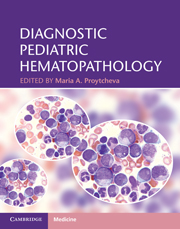Book contents
- Frontmatter
- Contents
- List of contributors
- Acknowledgements
- Introduction
- Section 1 General and non-neoplastic hematopathology
- 1 Hematologic values in the healthy fetus, neonate, and child
- 2 Normal bone marrow
- 3 Disorders of erythrocyte production
- 4 Disorders of hemoglobin synthesis
- 5 Hemolytic anemias
- 6 Inherited and acquired bone marrow failure syndromes associated with multiple cytopenias
- 7 Inherited bone marrow failure syndromes and acquired disorders associated with single peripheral blood cytopenia
- 8 Peripheral blood and bone marrow manifestations of metabolic storage diseases
- 9 Reactive lymphadenopathies
- Section 2 Neoplastic hematopathology
- Index
- References
8 - Peripheral blood and bone marrow manifestations of metabolic storage diseases
from Section 1 - General and non-neoplastic hematopathology
Published online by Cambridge University Press: 03 May 2011
- Frontmatter
- Contents
- List of contributors
- Acknowledgements
- Introduction
- Section 1 General and non-neoplastic hematopathology
- 1 Hematologic values in the healthy fetus, neonate, and child
- 2 Normal bone marrow
- 3 Disorders of erythrocyte production
- 4 Disorders of hemoglobin synthesis
- 5 Hemolytic anemias
- 6 Inherited and acquired bone marrow failure syndromes associated with multiple cytopenias
- 7 Inherited bone marrow failure syndromes and acquired disorders associated with single peripheral blood cytopenia
- 8 Peripheral blood and bone marrow manifestations of metabolic storage diseases
- 9 Reactive lymphadenopathies
- Section 2 Neoplastic hematopathology
- Index
- References
Summary
Introduction and general considerations
Metabolic storage diseases are rare disorders that have a wide spectrum of clinical and pathologic findings, depending on the genetic mutation inherited and the biochemical pathway disrupted. Most involve deficiency of a lysosomal enzyme, cofactor, or transport protein, resulting in accumulation of glycolipid or glycoprotein substances in the lysosome. As the presenting signs and symptoms can be variable, the peripheral blood smear or bone marrow findings may be the first clue that the patient has one of these disorders. Although the morphologic features for many of these are quite characteristic, none are entirely specific, and the diagnosis is best made utilizing a combination of clinical features, blood and marrow morphology, and biochemical testing of peripheral blood leukocytes or cultured skin fibroblasts. Targeted molecular diagnostic studies for specific mutations may be helpful to confirm the diagnosis for certain disorders, especially if there is an already characterized mutation within a family. Accurate diagnosis is important, as enzyme replacement therapy or other treatment has become available for several of these disorders.
Although the sites of accumulation of excess glycoprotein or glycolipid may vary, nearly all of these disorders involve the reticuloendothelial system to some extent, and many present with splenomegaly or hepatosplenomegaly. Splenomegaly may be quite pronounced, and cytopenias, specifically thrombocytopenia and anemia, are commonly seen at some stage at least in part due to hypersplenism. Lymph node and thymic involvement are also commonly seen, although prominent lymphadenopathy is unusual.
- Type
- Chapter
- Information
- Diagnostic Pediatric Hematopathology , pp. 135 - 141Publisher: Cambridge University PressPrint publication year: 2011
References
- 2
- Cited by



